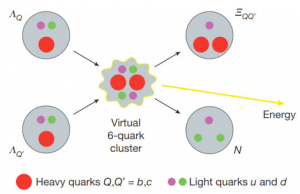The essence of nuclear fusion is that energy can be released by the rearrangement of nucleons between the initial- and final-state nuclei. The recent discovery1 of the first doubly charmed baryon  , which contains two charm quarks (c) and one up quark (u) and has a mass of about 3,621 megaelectronvolts (MeV) (the mass of the proton is 938 MeV) also revealed a large binding energy of about 130 MeV between the two charm quarks. Here we report that this strong binding enables a quark-rearrangement, exothermic reaction in which two heavy baryons (Λc) undergo fusion to produce the doubly charmed baryon
, which contains two charm quarks (c) and one up quark (u) and has a mass of about 3,621 megaelectronvolts (MeV) (the mass of the proton is 938 MeV) also revealed a large binding energy of about 130 MeV between the two charm quarks. Here we report that this strong binding enables a quark-rearrangement, exothermic reaction in which two heavy baryons (Λc) undergo fusion to produce the doubly charmed baryon  and a neutron n (
and a neutron n ( ), resulting in an energy release of 12 MeV. This reaction is a quark-level analogue of the deuterium–tritium nuclear fusion reaction (DT → 4He n). The much larger binding energy (approximately 280 MeV) between two bottom quarks (b) causes the analogous reaction with bottom quarks (
), resulting in an energy release of 12 MeV. This reaction is a quark-level analogue of the deuterium–tritium nuclear fusion reaction (DT → 4He n). The much larger binding energy (approximately 280 MeV) between two bottom quarks (b) causes the analogous reaction with bottom quarks ( ) to have a much larger energy release of about 138 MeV. We suggest some experimental setups in which the highly exothermic nature of the fusion of two heavy-quark baryons might manifest itself. At present, however, the very short lifetimes of the heavy bottom and charm quarks preclude any practical applications of such reactions.
) to have a much larger energy release of about 138 MeV. We suggest some experimental setups in which the highly exothermic nature of the fusion of two heavy-quark baryons might manifest itself. At present, however, the very short lifetimes of the heavy bottom and charm quarks preclude any practical applications of such reactions.
Publication in Nature, Nov. 2nd 2017



















